Last updated: March 20, 2023
Article
Milkweed and Monarchs
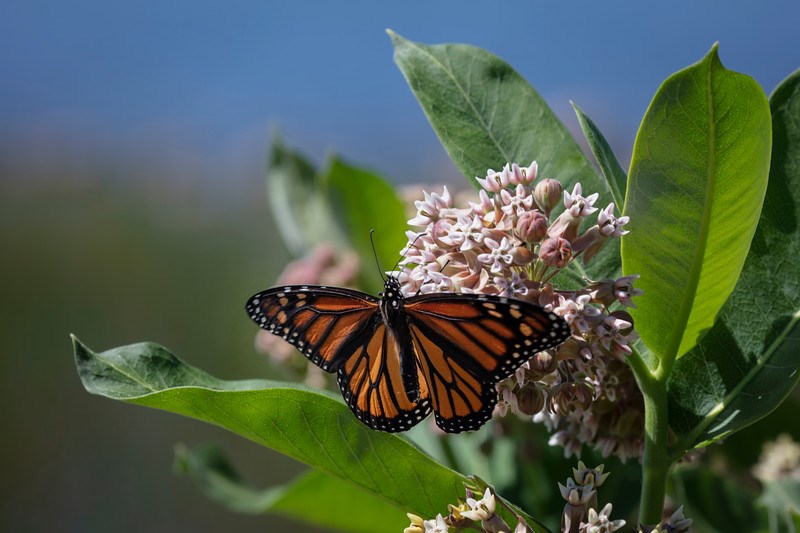
Yehyun Kim, Friends of Acadia.
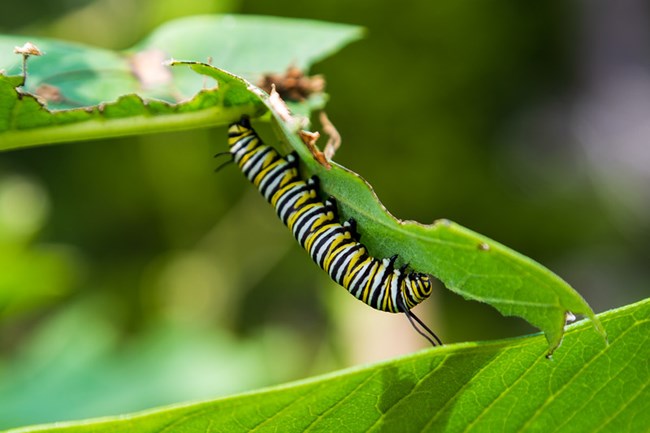
Friends of Acadia / NPS.
A long, shared history
This journey would not be possible—or even exist—without the monarch’s well-known host plant, milkweed. The monarch butterfly species, Danaus plexippus, has existed for an estimated one million years. Long before that, the monarch’s ancestors had similar traits that would allow for long-distance flight, suggesting that butterfly migration is even older than the monarchs themselves. It wasn’t until 20,000 years ago, however, that monarchs dispersed from their origin in North America to Central America, South America, and the Caribbean. After the peak of the last ice age, receding glaciers and a warmer climate allowed milkweed to colonize new areas. The monarch butterfly followed milkweed around the world, and its range now includes the North Atlantic coast of Africa, Europe, and the South Pacific.Milkweed is the common name for many plants in the genus Asclepias. It is an herbaceous perennial, recognizable by its broad opposite leaves, colorful flower clusters, or seed pods filled with silk that carries its wind-dispersed seeds. Monarch butterflies only lay eggs on milkweed and monarch caterpillars only feed on milkweed leaves. The key to this specialized relationship is found in the milky latex produced by the plant, which contains compounds called cardiac glycosides that are poisonous to most other animals. The monarch butterfly has developed resistance to this toxin, giving caterpillars a strong chemical defense against predators. In response, milkweed is trending toward faster regrowth following monarch caterpillar activity rather than increased toxicity. This is an example of coevolution, the process of living things influencing one another over thousands or millions of years.
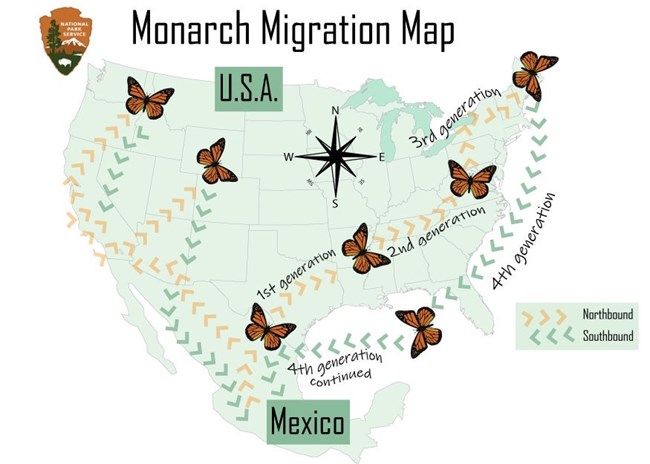
NPS.
Mexico to Maine (and back again)
Each year, the monarch population of eastern North America makes a multi-generation migration that spans thousands of miles. In March, monarch butterflies leave overwintering sites in the Sierra Madre mountains of Michoacán and México. They travel 50-100 miles a day, reaching Texas and Oklahoma to lay eggs on milkweed before the end of their lifespan. These eggs are the year’s first generation of monarchs, which develop into adults in as few as 25 days before continuing the journey north. Each month from May to August, a new generation of monarchs emerges from eggs laid on milkweed, feeds exclusively on milkweed, and undergoes a complete metamorphosis. The second and third generations each travel hundreds of miles north until the population reaches the northern United States and Canada. A fourth generation develops in the northernmost part of the monarch’s range—the great-grandchildren of the monarchs that spent the winter in Mexico.
This fourth generation, including monarchs that begin their lives in Maine, will retrace the entire route their parents, grandparents, and great-grandparents have traveled. This is the only two-way migration made by a butterfly. In fact, despite its far-reaching distribution, not all monarchs migrate. Distinct populations in Florida, South and Central America, the Pacific, and Atlantic no longer migrate to the same degree as their North American ancestors, if at all. The two North American populations on the east and west coasts are the only long-distance migrating butterflies in the world.
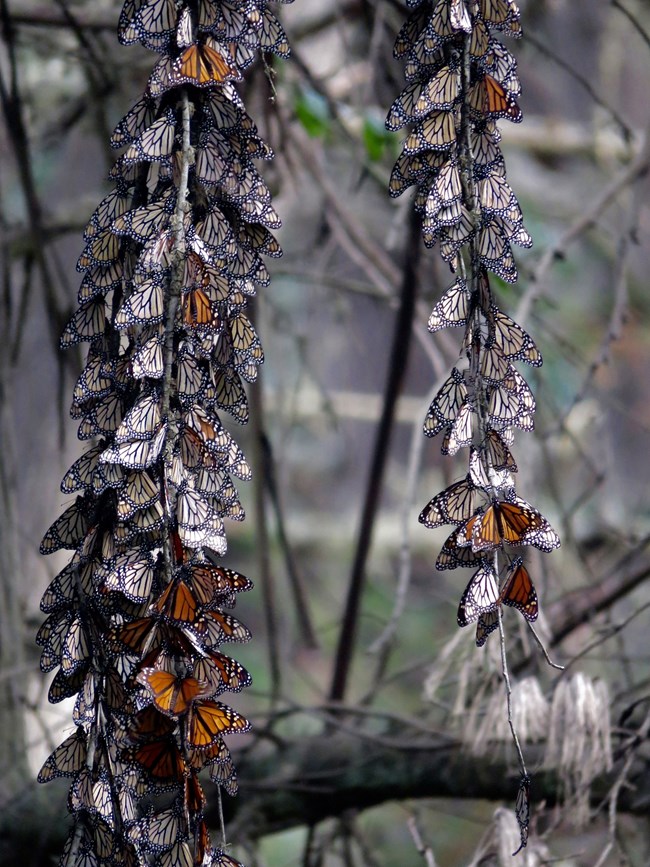
NPS Photo.
Conservation Status
There is increasing awareness of the environmental threats and population decline monarch butterflies are facing. The International Union for Conservation of Nature (IUCN) evaluates the conservation status of species worldwide and works with the United Nations. In July 2022, the IUCN listed the migratory monarch butterfly as endangered on its Red List of Threatened Species. On a national level, the Endangered Species Act (ESA) provides United States government agencies the authority to evaluate species conservation status and offer legal protections to those listed as endangered or threatened. In 2014, the USFWS accepted a petition to list the monarch butterfly as a threatened species under the ESA; at this time, however, the monarch is waiting in the wings as a candidate for official protection while species considered to be at more immediate risk are prioritized.These status changes both require extensive scientific research, review, and consensus—to what extent are migratory monarch populations declining and why? The eastern population of monarchs accounts for over 90% of all monarch butterflies worldwide. Just thirty years ago, hundreds of millions of monarchs were recorded at overwintering sites annually; today, that number has fallen below 80 million.
The monarch butterfly is not alone in its plight. Insects account for 5.5 million of the 8 million estimated plant and animal species on Earth. 40% of all insect species are rapidly declining and could go extinct within decades. Lepidoptera, the order of insects including butterflies and moths, is one of the most at-risk due to their dependence on specific plant species. In Maine, one in five butterfly species is listed as a species of concern, threatened, or endangered.
The primary reasons for these losses are disappearing habitat, climate change, and pesticide use. Crop and livestock production currently occupies one third of the world’s land surface, and continued agricultural expansion into natural areas and reliance on insecticides harms non-target insect species. Habitat loss due to agriculture, logging, and urbanization is worsened by fires, storms, droughts, and invasive species associated with ongoing climate change. These are complex global issues, but, for monarch populations at least, taking action at the local level is an important part of the solution.
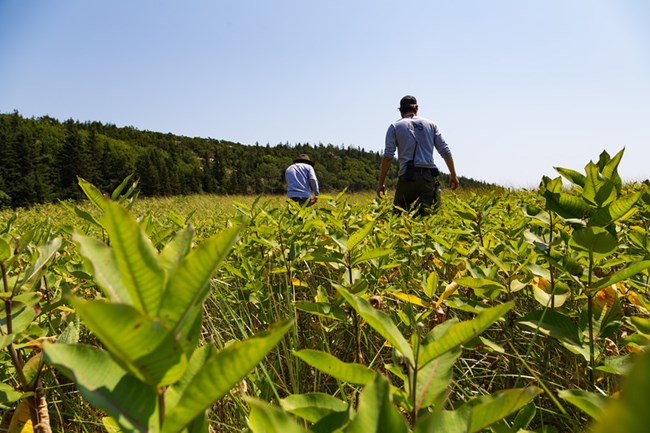
Friends of Acadia / NPS.
Habitat Restoration
Acadia National Park may represent a tiny fraction of the state, but its diverse array of ecosystems supports 41% of plant species and 51% of plant communities present in Maine. Yet even this protected place is not immune to the effects of invasive plants, forest pests, and climate change. While over 860 plant species are found in Acadia today, there are historical records of 200 species that have disappeared in recent decades. Park managers work to protect and restore native vegetation that supports wildlife, and you can take on this same role at home or in your community. This work is just as important beyond the park boundary because monarch butterflies must pass through developed areas where milkweed and nectar sources are scarce.There are over 200 different species of milkweed worldwide, but Asclepias syriaca, or common milkweed, is the only one found in Acadia National Park. The NPS avoids mowing milkweed in places like the Hulls Cove Visitor Center parking lot and along Park Loop Road. This is a small but significant action visitors can apply at home—plant milkweed, or simply leave it in place.
The connection between milkweed and monarchs continues to raise public awareness of plant-pollinator relationships, but it is far from the only example. Insects, birds, and other animals have specialized relationships with native plants too. Each of the 121 butterfly species found in Maine relies on specific larval host plants and nectar sources. The spicebush swallowtail butterfly was considered locally extinct until caterpillars were found in a small area of remaining habitat for its state-rare host plants, sassafras and spicebush. The Clayton’s copper butterfly, listed as endangered in Maine, is found in fewer than ten locations statewide because its only host plant, shrubby cinquefoil, needs specific soil conditions to grow. The federally endangered Karner blue butterfly depends on Maine’s native sundial lupine, which has all but disappeared from much of its native range. A common theme emerges from the stories of these increasingly rare species: when native plants disappear from the landscape, the butterflies do too.
